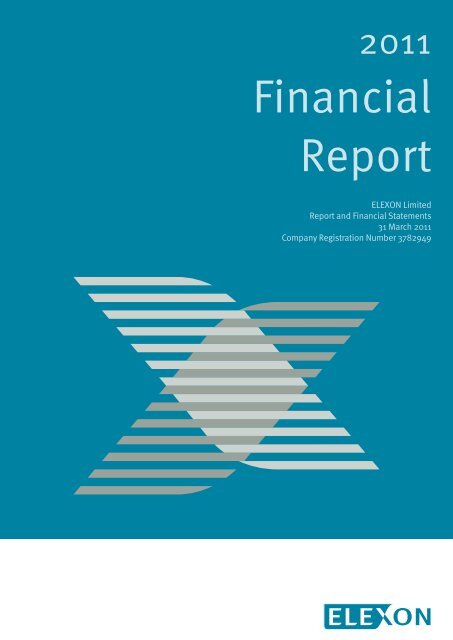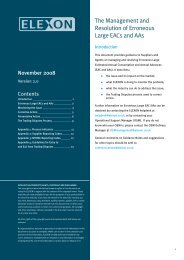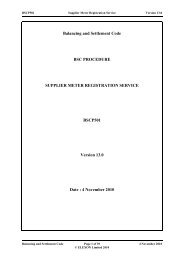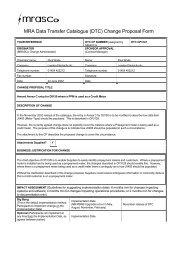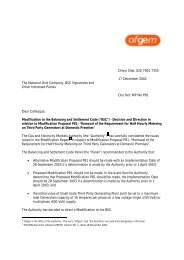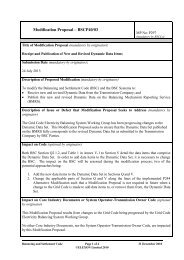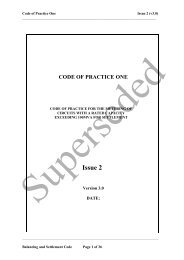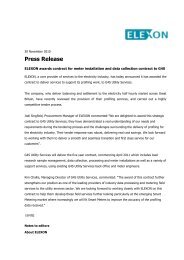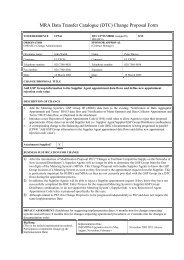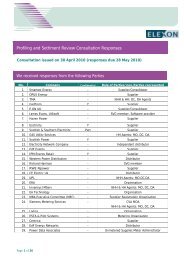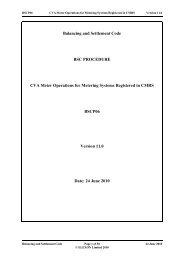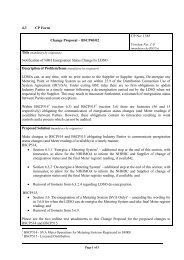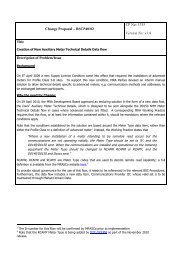31 March 2011 - Elexon
31 March 2011 - Elexon
31 March 2011 - Elexon
- No tags were found...
You also want an ePaper? Increase the reach of your titles
YUMPU automatically turns print PDFs into web optimized ePapers that Google loves.
<strong>2011</strong>FinancialReportELEXON LimitedReport and Financial Statements<strong>31</strong> <strong>March</strong> <strong>2011</strong>Company Registration Number 3782949
Contents01 Officers and Professional Advisers....................................................................................... 302 Report of the Chairman and Chief Executive.......................................................................... 403 Report of the Directors......................................................................................................... 604 Corporate Governance Statement......................................................................................... 905 Statement of Directors’ Responsibilities..............................................................................1406 Independent Auditor’s Report to the Members of ELEXON Limited........................................ 1507 Consolidated Profit and Loss Account.................................................................................. 1708 Consolidated Balance Sheet...............................................................................................1809 Company Balance Sheet.....................................................................................................1910 Consolidated Cash Flow Statement.................................................................................... <strong>2011</strong> Notes to the Accounts.........................................................................................................212
01. Officers andProfessional AdvisersDIRECTORSNick Durlacher (Chairman, resigned 30 September 2010)Andrew Pinder (Chairman, appointed 1 October 2010)Jane E TozerBarbara VestPeter Teague(Non-executive)(Non-executive)(Non-executive)Sebastian Eyre (Non-executive, resigned 30 September 2010)Nigel Cornwall (Non-executive, appointed 14 October 2010)COMPANY SECRETARYNicholas BrownREGISTERED OFFICE4th Floor350 Euston RoadLondon NW1 3AWBANKERSBarclays Bank plc54 Lombard StreetLondon EC3P 3AHSOLICITORSHerbert SmithExchange HousePrimrose StreetLondon EC2A 2HSSNR DentonOne Fleet PlaceLondon EC4M 7WSAUDITORDeloitte LLPChartered AccountantsLondonSlaughter and May1 Bunhill RowLondon EC1Y 8YYThring Townsend Lee & PembertonKinnard House1 Pall Mall EastLondon SW1Y 5AU3
02. Report of the Chairmanand Chief Executivefulfil a wider role and take a more active approach toproviding solutions to common industry problems. Thiswork will continue into the year ahead. We’re committedto engaging with the industry on what the final solutionlooks like and will continue to keep our customers andstakeholders up to date on our progress.Chairman Andrew Pinder2.1 Report from the ChairmanSince being appointed as Chairman of ELEXON inOctober 2010, it’s become increasingly apparent to methat we are operating in a time of momentous industrychange. The introduction of smart meters is fast looming.Set this alongside the Government’s Electricity MarketReform proposals, and it’s clear that we’re in the midstof some of the most radical changes to the marketsince privatisation.A period of such change presents us with challenges,but also some great opportunities. As the Governmentcommits to rapid transformation of the sector to securereliable, affordable and sustainable energy, ELEXON islooking for ways to support the industry in this changeagenda. ELEXON has a key role to play in providingstability and protecting the core of settlement throughoutthis period of change, whilst also being well placed touse our considerable expertise and talent to help steerthe industry towards improved efficiency.At the end of 2010, the draft BSCCo Business Strategy for<strong>2011</strong>/12 highlighted our belief that ELEXON’s governanceframework is preventing us from fully applying ourexpertise, experience and assets to support the industrythrough this period of change. We’ve been working forsome months now with DECC, Ofgem and other BSCStakeholders to review ELEXON’s governance structureso that we’re operating under a model that is fit forpurpose in a rapidly developing market, allowing us to2.2 Report from the CEOThe last financial year was a busy one for ELEXON. At atime of considerable market upheaval, ELEXON has takensome very significant steps forward to develop in orderto meet the challenges the industry is facing, particularlyaround smart metering and the consequential evolutionof settlement.Doing more with fewer people; securing valueand innovationIn July, we implemented an internal restructure. Weconsolidated all of our operational teams into onedepartment, giving us real scope for deliveringoperational efficiencies whilst also freeing up someof our expert resource to work on key areas such assmart metering and code development.We have been, and will continue to be, constantlymindful of the need to drive down our costs and how wecould save the industry money. One of our operationalsuccesses of 2010/11 was our review of the ProfileAdministrator Agent Service, the outcome of which willenable us to deliver a better, more flexible service at lesscost to the industry.Last year’s Business Strategy committed us to seekingopportunities to do more with our capabilities andassets to benefit our customers. We’re now deliveringmore with fewer people, and making better use ofELEXON’s significant technical expertise. We’ve carriedthis commitment into our <strong>2011</strong>/12 Business Strategy.The overall costs for 2010/11 were £30.4m (£1.7m lessthan our approved budget and £1.2m less than theoverall costs for 2009/10).4
Supporting the wider change agendaIt is my view that ELEXON has a duty to provideexpertise and input into wider reforms and changesthat have an impact on the operation of the UK energymarket. Over the course of the year, we’ve respondedto several industry consultations including Ofgem’sreview of current metering arrangements, theGovernment’s Electricity Market Reform proposalsand Ofgem and DECC’s consultations on the SmartMetering Implementation Programme. Our expertshave been assisting Ofgem and DECC with end-to-endbusiness process modelling for the smart meteringarrangements and have begun the important, and notinsignificant, challenge of considering how settlementwill need to adapt and how the BSC can betterfacilitate tariff innovation in a smart metered world.We’ve also actively contributed to delivering theoutputs of Ofgem’s Code Governance Review.We’ve taken a leading role in drafting the codeadministrators’ code of practice – which reinforcesmany of the activities we previously undertook aspart of our own best practice review.Working with ELEXON’s service providersThroughout 2010/11, we’ve been bedding in the newcontracts procured under our Isis programme for theoperation, hosting, maintenance and developmentof the BSC Applications. In partnership with our keyservice providers, Cognizant and Logica, we’re alreadystarting to deliver substantial cost savings and greatervalue to our customers. Through a combination ofnegotiations via procurement projects and byeffectively managing all our agents, we’ve achievedtotal contracted costs of £13.6m (£604k less than thecorresponding figure in 2009/10).A customer-centric approachThe results of our 2010 customer survey were some of ourbest ever. More customers than last year felt that ELEXONwas improving; the overall rating of ELEXON and our valuefor money score improved, particularly among smallercompanies. The website remained the area that customersmost wanted to see improved. In partnership with Cognizantand Logica, we’ve listened to your feedback and reviewed allour web platforms to deliver a new ELEXON website andmove all our operational data onto the ELEXON Portal,enabling customers to benefit from upgraded operationaldata and easier navigation.To continue improving in all areas, we must carry onseeking feedback from our customers and developinggreater insight into their needs. We’ll build on thequestions we’ve been asking this year and continue beingcurious about what we could do better, looking for moreopportunities to deliver value and building on the ‘criticalfriend’ role that we’ve adopted so successfully in deliveringthe modification process.Andrew PinderChairmanChief Executive Peter HaighPeter HaighChief Executive5
03. Report of the DirectorsThe Directors present their annual report and the auditedfinancial statements for the year ended <strong>31</strong> <strong>March</strong> <strong>2011</strong>.Principal ActivitiesELEXONELEXON Limited (ELEXON) is the parent Company of agroup of companies whose principal role, as set outin the BSC, is to provide and procure the facilities,resources and services required for the proper,effective and efficient implementation of the BSC.ELEXON is wholly owned but not controlled by NationalGrid Electricity Transmission plc (NGET) and is notconsolidated in NGET’s financial statements. ELEXON’sindependence of NGET is established by the BSC. Themanagement of ELEXON is not controlled by NGET as allof ELEXON’s Directors are appointed independently.Section C of the BSC prescribes the constitution ofELEXON, its role, powers, management, liability positionand subsidiaries.ELEXON has a Board of Directors comprising five persons.The Chairman is appointed by the Gas and ElectricityMarkets Authority (the Authority) for a fixed term to chairthe BSC Panel and, in accordance with the BSC, to alsochair the Board of the Company. Two of the othermembers of the Board, in accordance with the BSC, arenominated by the BSC Panel from among the Panelmembers elected by BSC Trading Parties (thus ensuringthat the industry that pays the costs of ELEXON isrepresented on its Board). The other two members of theBoard are, in accordance with the BSC and the formalBoard and corporate governance processes, selected bythe Chairman after consultation with the Panel, to bringrelevant expertise to the Board’s deliberations. TheChairman devotes a minimum of three days per week toBoard and Panel matters. The other Board members arenon-executive and all serve for fixed terms.ELEXON has four wholly-owned subsidiaries: ELEXONClear Limited, Poolserco Limited, Poolit Limited andBSC Co. Limited. These are described below.ELEXON Clear LimitedELEXON Clear Limited (ELEXON Clear) is the legalcounterparty to balance and imbalance transactionsunder the BSC. ELEXON Clear has the same Directors asELEXON and has a broadly similar Memorandum (saveas to objects) and Articles of Association. ELEXON Clearis referred to in the BSC as the BSC Clearer.Poolserco LimitedAs part of the transition from the Electricity Pool ofEngland and Wales (the Pool) to the New ElectricityTrading Arrangements (NETA) reflected in the BSC,Poolserco Limited (Poolserco) held contracts with variousservice providers for activities required under the BSC.These contracts have been novated to ELEXON Limitedand Poolserco Limited has ceased trading.Poolit LimitedPoolit Limited (Poolit) holds mainly historic intellectualproperty developed by Pool Members jointly under thePool. Poolit is a non trading Company.BSC Co. LimitedBSC Co. Limited was acquired from NGET in <strong>March</strong> 2009and is a dormant company.Business ReviewELEXON and its subsidiaries form a not-for-profitgroup which recoups its costs from BSC Parties inaccordance with the terms of the BSC. All licensedelectricity generators and suppliers in Great Britainare obliged to become signatories to the BSC. Othercompanies may choose to do so.6
Turnover for the year to <strong>31</strong> <strong>March</strong> <strong>2011</strong> was £30.4m,compared with £<strong>31</strong>.5m, in the previous year. Thisrepresents total expenditure and is recharged to TradingParties under the provisions of Section D of the BSC. Asthe Group is not for profit, costs and interest charges areexactly matched by turnover for the year. In order toachieve this there has been a reconciliation of amountscharged to Trading Parties for the 2010/11 financial yearbased on the final audited costs and interest chargesshown in this report. A credit of £632k for the 2010/11financial year will be returned to BSC Trading Parties inAugust <strong>2011</strong>.This is ELEXON’s tenth full year of operation. Since thestart of the balancing and settlement arrangementsELEXON’s costs, net of interest, have fallen from £71.8min 2001 to £30.4m. Costs for the year have reduced by£1.2m mainly as a result of re-procurement and effectivemanagement of our service providers.Overall, ELEXON reported a £1.7m underspend againstthe 2010/11 Annual Budget of £32.1m. Looking forward,the budget for <strong>2011</strong>/12 has been set at £35.5m. The<strong>2011</strong>/12 budget includes one-off investment inorganisational development of £1m and SMART costs of£3m to enable us to develop our business to addressindustry challenges through embracing opportunitiesarising from the SMART Metering Programme.Financial Risk ManagementThe Group is exposed to financial risk through itsfinancial assets and liabilities. The key financial risk isthat the proceeds from financial assets are not sufficientto fund the obligations arising from liabilities as they falldue. The most important components of financial riskare interest rate risk, currency risk, credit risk, liquidityrisk, cash flow risk and price risk. Due to the nature ofthe group’s business and the assets and liabilitiescontained within the group’s balance sheet, the onlyfinancial risks the Directors consider relevant are creditrisk, particularly in relation to the large deposits heldby ELEXON Clear, and liquidity risk. These risks aremitigated by the nature of the debtor balances owed,with the BSC providing for other BSC Parties to meet theliabilities of any debtor in default.Going ConcernThe Group has arranged a £0.1m overdraft facility forELEXON and £1.0m overdraft facility for ELEXON Clearrespectively with Barclays PLC at the variable rate of 1.75percent above the bank’s base rate. The Board believethat this provides a secure financial base for the Group forthe foreseeable future. Financial risks are also mitigatedby the nature of the debtor balances owed, with the BSCproviding for other BSC Parties to meet the liabilities ofany debtor in default; and the provision of the BSCTable 1: Five Year Comparison FiguresYear Ended<strong>31</strong> <strong>March</strong><strong>2011</strong>Year Ended<strong>31</strong> <strong>March</strong>2010Year Ended<strong>31</strong> <strong>March</strong>2009Year Ended<strong>31</strong> <strong>March</strong>2008Year Ended<strong>31</strong> <strong>March</strong>2007£’000 £’000 £’000 £’000 £’000Turnover 30,367 <strong>31</strong>,5<strong>31</strong> 35,323 34,323 33,074Cost of Sales (30,380) (<strong>31</strong>,569) (35,463) (34,486) (33,250)Net Interest Income 13 38 140 163 1767
whereby ELEXON recovers its cost one month in advance.As a result, the Board considers that there is a reasonableexpectation that the Group will continue in operatingexistence for the foreseeable future and has thereforeused the going concern basis of accounting in thepreparation of the financial statements.EnvironmentalELEXON recognises the importance of its environmentalresponsibilities and has formally adopted anenvironmental policy which aims continually to monitorand reduce its impact on the environment through the useof recycled resources where appropriate, recycling, safedisposal of electrical and hazardous waste, redundantstationery and equipment and energy saving measures.EmployeesDetails of the number of employees and related costs aregiven in note 11.3.DividendsUnder the terms of the BSC, the Company has no poweror authority to declare or pay any dividends.Payment to Suppliers of Goods and ServicesThe Group agrees terms and conditions for its businesstransactions with suppliers of goods and services.Payment is then made in accordance with these terms,subject to compliance by the suppliers with therequirements of their contracts. Trade creditors of theCompany at <strong>31</strong> <strong>March</strong> <strong>2011</strong> were equivalent to 16 days’purchases (2010: 36 days’), based on the average dailyamount invoiced by suppliers to the Company duringthe year.Directors and Their InterestsThe membership of the Board during the year is set outbelow. Details of Directors’ remuneration are given innote 11.3 to the financial statements. None of theDirectors had any interests in the share capital of theCompany or any other Group Companies.The Company has made qualifying third party indemnityprovisions for the benefit of its directors which weremade during the year and remain in force at the date ofthis report.DirectorsThe Directors at <strong>31</strong> <strong>March</strong> <strong>2011</strong> were as follows:Andrew Pinder (Chairman)Peter TeagueJane E TozerBarbara VestNigel CornwallAuditorDeloitte LLP has expressed its willingness to continue inoffice as auditor and a resolution to reappoint them willbe proposed at the forthcoming Annual General Meeting.Each of the persons who is a director at the date ofapproval of this report confirms that:• so far as the director is aware, there is no relevantaudit information of which the Company’s auditoris unaware; and• the director has taken all the steps that he/sheought to have taken as a director in order to makehimself/herself aware of any relevant auditinformation and to establish that the company’sauditor is aware of that information.This confirmation is given and should be interpreted inaccordance with the provisions of s418 of the CompaniesAct 2006.Approved by the Board of Directors and signed on behalfof the Board.Nicholas BrownCompany Secretary16 June <strong>2011</strong>8
04. Corporate Governance StatementELEXON complies with the UK Corporate GovernanceCode to the extent this is applicable to the Group. WhilstELEXON is not a listed Company, the Company’s Boardappreciates the value of good corporate governance, andconsiders compliance with the Corporate GovernanceCode appropriate given the unique position of theCompany and its accountability and responsibility tothe electricity industry.Throughout the year ended <strong>31</strong> <strong>March</strong> <strong>2011</strong> the Groupcomplied with the UK Corporate Governance Code,except in the limited circumstances where the BSC takesprecedence over the UK Corporate Governance Code orwhere compliance is not practicable or appropriate dueto the nature, structure and function of ELEXON. Anyarea in which ELEXON is not in accordance with the UKCorporate Governance Code is noted below.A general narrative statement relating to the governanceof the Group appears below. This statement comprisesfour parts: Board and Directors, Directors’Remuneration, Relations with Shareholders andAccountability and Audit.Board and DirectorsThe Company is controlled through the Board ofDirectors, which comprises four non-executiveDirectors, plus the Chairman.In accordance with the BSC, the Chairman of the BSCPanel (who is appointed by the Authority) is also theChairman of the Board. One of the primaryresponsibilities of the Chairman is the leadership ofthe Board. As part of this responsibility the Chairmanensures that all Directors receive sufficient, accurateand relevant information on financial, business andcorporate issues in a timely manner prior to meetings.The Chairman had no significant commitments outsidethe ELEXON Group and the BSC Panel, during the yearended <strong>31</strong> <strong>March</strong> <strong>2011</strong>.The Board considers all non-executive Directors to beindependent. One non-executive Director, BarbaraVest, has served on the Board for more than ten years.Barbara Vest is a Panel Member who has been appointedto the Board following an election by eligible PanelMembers in accordance with the BSC.The non-executive Directors normally hold one meetingwithout the Chairman and the Executive Team beingpresent. This meeting takes place in order to accordwith the requirements of the UK Corporate GovernanceCode. The formal meeting between non-executiveDirectors and the Chairman without the Executive Teampresent did not take place in <strong>2011</strong>. A new Chairman wasappointed part way through the year and the meeting waspostponed until the Chairman had been in post for anappropriate time.The Board has not considered it necessary or appropriateto appoint a senior independent Director as suggested inthe UK Corporate Governance Code. This is because theprimary purpose of a senior independent Director is forthe benefit of institutional shareholders (which theCompany does not have).The BSC prescribes how the Directors are appointed andremoved, and the terms of office which apply to the PanelDirectors. It also specifies the number of members of theBoard, its structure and its composition. The Companytherefore cannot comply with the requirements of the UKCorporate Governance Code in relation to the balancebetween executive directors and non-executive directorsand cannot comply in full with the process for appointingnew Directors (for example, the use of an external searchconsultant or open advertising only takes place in relationto the appointment of the non-Panel Directors). The BSCsets up a formal and transparent procedure for theappointment of new Panel Directors.All new or re-appointed Directors are required to sign astandard letter setting out the terms of their appointmentand explaining the time commitment which is expected of9
them. The Directors are expected to undertake regulartraining to update and refresh their skills and knowledge.The BSC sets out the role of the Chief Executive. Itrequires the Board to delegate authority to conduct theday-to-day business of the Company to the ChiefExecutive. In addition, the Company has clearlyestablished, in accordance with the UK CorporateGovernance Code and corporate governance bestpractice, a schedule of matters reserved for the Boardand a written division of responsibilities between theChairman and the Chief Executive. The Chief Executive isnot a Director of the Company but is entitled to receivenotices of and attend and speak (but not to vote) at allmeetings of the Board. The Board may require the ChiefExecutive to be absent from any part of a meeting atwhich any matter concerning his employment by theCompany is being considered.The day-to-day management of the Company is performedby the Chief Executive in conjunction with the ExecutiveTeam, comprising the heads of the various Departments.The Board receives the benefit of input from anddiscussion with the Chief Executive and members of theExecutive Team by way of their regular attendance atBoard meetings.The BSC prescribes various Board duties andresponsibilities, such as approval of the annual budget.The Board generally meets on a monthly basis andotherwise will meet as required to conduct its business.Its activities include monitoring exposure to key businessrisks, setting and reviewing the strategic direction of theGroup, reviewing progress towards achievement ofobjectives, ensuring that the necessary financial andhuman resources are in place for the Company to meet itsobjectives, reviewing management performance, settingthe Company’s values and standards, ensuring that itsobligations under the BSC are understood and met andreviewing expenditure against budget.The Board carries out annual evaluations of its ownperformance and that of its Committees. Each Committeealso carries out an annual evaluation of its ownperformance, and evaluations are also carried out of theperformance of individual Directors and of the Chairman.These evaluations are carried out in accordance with theprocess approved by the Board using a questionnairetailored for the relevant evaluation. Evaluations of theChairman and each non-executive Director have beenpostponed until the new Chairman has been in post foran appropriate period of time to allow for meaningfulevaluations.The Board has established an Audit Committee and aRemuneration and Nomination Committee. Membershipof these Committees comprises all Directors. This isconsidered appropriate bearing in mind the structure andcomposition of the Board as specified by the BSC. PeterTeague, who has recent, relevant and significant financialexperience, chairs the Audit Committee. The Chairman ofthe Board, Andrew Pinder, chairs the Remuneration andNomination Committee. This is considered appropriatebecause of the BSC requirements relating to the role ofthe Chairman. The minutes of the Board and of theseCommittees are circulated to and reviewed by the Boardof Directors.The main roles and responsibilities of the AuditCommittee are to:• monitor the integrity of the financial statementsof the Company, reviewing significant financialreporting judgements contained in them;• review the Company’s internal financial controland risk management systems, and to monitorand review the effectiveness of the company’sinternal audit function;• make recommendations to the Board in relationto the appointment of the external auditor andto approve the remuneration and terms ofengagement of the external auditor;• monitor and review the external auditor’sindependence, objectivity and effectiveness,taking into consideration relevant UKprofessional and regulatory requirements;10
• develop and implement policy on the engagementof the external auditor to supply non-auditservices, taking into account relevant ethicalguidance regarding the provision of non-auditservices by the external audit firm;• review arrangements by which staff of theCompany may in confidence raise any concerns;and• report to the Board identifying any matters inrespect of which it considers that action orimprovement is needed and makingrecommendations on the steps to be taken.In discharging these responsibilities, the AuditCommittee considers reports from the external auditor,internal auditors and from management, and monitorsthe implementation of any necessary actions includingan independent review of nominated areas of internalcontrol.The Audit Committee also gives regular consideration tothe independence of the external auditor. Where theexternal auditor has provided non-audit services theAudit Committee has concluded that the value of thisAttendance at Meetings 2010/11work is not so significant as to affect the independenceof the auditor.The role of the Remuneration and Nomination Committeein remuneration matters is to make recommendations tothe Board on changes to the terms and conditions ofappointment of the Executive Team, to determine theframework for the remuneration of the Executive Team, tooversee the general remuneration policy of the Company(in particular the salary and bonus arrangements for theExecutive Team) and to be aware of, advise on andoversee any major changes in employee benefitstructures throughout the Company.The role of the Remuneration and Nomination Committeein nomination matters is to ensure that there is a properprocedure in place for the appointment of new nonPanel/Industry Directors to the Board, and to ensure thatsuccession plans are in place for Board members andmembers of the Executive Team so as to maintain anappropriate balance of skill and expertise within theCompany and the Board. The Remuneration andNomination Committee does not have a role in relationto the selection of new Panel/Industry Directors as theprocess for the selection of these Directors is set out inthe BSC.Name of DirectorAttendance atBoard meetingsAttendance atRemuneration &Nomination CommitteesTotal Number ofMeetings9 4 3Nick Durlacher * 5 3 1Andrew Pinder *8 (4 as Chairman Designateand 4 as Chairman)4 (3 as Chairman Designateand 1 as Chairman)Peter Teague 8 4 3Jane E Tozer 9 4 3Barbara Vest 9 4 3Nigel Cornwall * 4 1 2Sebastian Eyre * 4 2 1Attendance atAudit Committees3 (1 as Chairman Designateand 2 as Chairman)* these Board members either joined or left part-way through the year11
Directors’ RemunerationNote 11.3 to the Financial Statements sets out theDirectors’ remuneration for the year.Relations with ShareholdersThe Company is wholly owned by National GridElectricity Transmission (NGET). The BSC provides thatthe Memorandum and Articles of Association of theCompany are incorporated into and form part of the BSC.Together these documents set out the constitution of theCompany, and the rights and responsibilities of NGET inrelation to the Company. NGET does not have the rightto appoint or remove Directors, change the Memorandumand Articles of Association or issue share capital in theCompany. Certain principles set out in the UK CorporateGovernance Code relating to shareholders and investorsdo not apply to the Company as a result of its nature andfunction and the nature, structure and composition ofits Board.Accountability and AuditFinancial ReportingThe Board considers that the Directors’ Report andthe Financial Statements present a balanced andunderstandable assessment of the Group’s position andprospects. The Directors’ responsibility for the FinancialStatements is described in section 5 of this report.Going ConcernArrangements are in place to manage financial risk, asstated on page 7 of the Report of the Directors. As aresult, the Board considers that there is a reasonableexpectation that the Company will continue in operatingexistence for the foreseeable future and has thereforeused the going concern basis of accounting in thepreparation of the financial statements.Internal ControlThe Board, via the Audit Committee, is responsible forthe Group’s system of internal control and for reviewingits effectiveness. Such a system is designed to managerather than eliminate the risk of failure to achievebusiness objectives and can only provide reasonable andnot absolute assurance against misstatement or loss.The Board is of the view that a comprehensive processfor identifying, evaluating and managing the Group’ssignificant risks has been in place for the entire reportingperiod and up to the date of the approval of thisdocument.The Directors (sitting either as the Board or as the AuditCommittee) review significant risks on a six monthlybasis. This includes reviewing a report from the ExecutiveTeam with commentary on:• the state of risk management and internal control;• any significant failings or weaknesses identifiedduring the period; and• actions taken to remedy any significantweaknesses.A complete review of ELEXON’s risk management systemwas carried out in 2010/11. The objective of this reviewwas to reassess our risks to better reflect our currentcircumstances as well as incorporate relevant, bestpractice improvements. A number of changes wereimplemented: the risks were reviewed and rationalised tobetter reflect ELEXON’s risk exposure, the register itselfwas reformatted and a new business risk register createdto manage departmental risk.The risk management process has also been updated:both corporate and business risks are assessed monthlyby the responsible individuals assigned to the risk. Themonthly assessment will consider whether the threat ofthe risk is reducing or increasing as a result of themitigation applied. Any new risks, both at a corporateand business level, will also be considered and addedas necessary.12
Risk changes will be collated by Corporate Assurance andreported to the monthly Executive Meeting. The Executivewill decide if any business risks should be escalated to acorporate risk. They will also assess which risk changesor events merit inclusion in the risk section of themonthly Chief Executive’s Report which is presented tothe Board.ELEXON has an Internal Audit function that provides theAudit Committee with independent, objective assuranceregarding internal controls and risk managementprocesses as part of the Company’s risk managementand assurance regime. The Audit Committee agrees aprogramme of internal audit work annually and reviewsprogress at each of its meetings with the head of theinternal audit function.Compliance StatementSubject to the sections noted above and where theBSC takes precedence over requirements set out in theUK Corporate Governance Code or such requirementsare not appropriate, the Group has complied with theprovisions of the UK Corporate Governance Codethroughout the year.13
05. Statement of Directors’ResponsibilitiesThe directors are responsible for preparing the AnnualReport and the financial statements in accordance withapplicable law and regulations.Company law requires the directors to prepare financialstatements for each financial year. Under that law thedirectors have elected to prepare the financial statementsin accordance with United Kingdom Generally AcceptedAccounting Practice (United Kingdom AccountingStandards and applicable law). Under company law thedirectors must not approve the financial statementsunless they are satisfied that they give a true and fair viewof the state of affairs of the company and of the profit orloss of the company for that period. In preparing thesefinancial statements, the directors are required to:The directors are responsible for the maintenanceand integrity of the corporate and financial informationincluded on the company’s website. Legislation inthe United Kingdom governing the preparation anddissemination of financial statements may differfrom legislation in other jurisdictions.• select suitable accounting policies and then applythem consistently;• make judgements and accounting estimates thatare reasonable and prudent;• state whether applicable UK Accounting Standardshave been followed, subject to any materialdepartures disclosed and explained in the financialstatements; and• prepare the financial statements on the goingconcern basis unless it is inappropriate to presumethat the company will continue in business.The directors are responsible for keeping adequateaccounting records that are sufficient to show and explainthe company’s transactions and disclose with reasonableaccuracy at any time the financial position of the companyand to enable them to ensure that the financialstatements comply with the Companies Act 2006. Theyare also responsible for safeguarding the assets of thecompany and hence for taking reasonable steps for theprevention and detection of fraud and other irregularities.14
06. Independent Auditor’s Reportto the Members of ELEXON LimitedWe have audited the financial statements of ELEXONLimited for the year ended <strong>31</strong> <strong>March</strong> <strong>2011</strong> which comprisethe Group Profit and Loss Account, the Group and ParentCompany Balance Sheets, the Group Cash Flow Statementand the related notes 11.1 to 11.22. The financial reportingframework that has been applied in their preparation isapplicable law and United Kingdom AccountingStandards (United Kingdom Generally AcceptedAccounting Practice).This report is made solely to the company’s members, asa body, in accordance with Chapter 3 of Part 16 of theCompanies Act 2006. Our audit work has beenundertaken so that we might state to the company’smembers those matters we are required to state to themin an auditor’s report and for no other purpose. To thefullest extent permitted by law, we do not accept orassume responsibility to anyone other than the companyand the company’s members as a body, for our auditwork, for this report, or for the opinions we have formed.Respective responsibilities of directorsand auditorAs explained more fully in the Directors’ ResponsibilitiesStatement, the directors are responsible for thepreparation of the financial statements and for beingsatisfied that they give a true and fair view. Ourresponsibility is to audit and express an opinion on thefinancial statements in accordance with applicable lawand International Standards on Auditing (UK and Ireland).Those standards require us to comply with the AuditingPractices Board’s Ethical Standards for Auditors.Scope of the audit of the financial statementsAn audit involves obtaining evidence about the amountsand disclosures in the financial statements sufficient togive reasonable assurance that the financial statementsare free from material misstatement, whether caused byfraud or error. This includes an assessment of: whetherthe accounting policies are appropriate to the group’sand the parent company’s circumstances and havebeen consistently applied and adequately disclosed;the reasonableness of significant accounting estimatesmade by the directors; and the overall presentation ofthe financial statements. In addition, we read all thefinancial and non-financial information in the annualreport to identify material inconsistencies with theaudited financial statements. If we become aware of anyapparent material misstatements or inconsistencies weconsider the implications for our report.Opinion on financial statementsIn our opinion the financial statements:• give a true and fair view of the state of the group’sand of the parent company’s affairs as at <strong>31</strong> <strong>March</strong><strong>2011</strong> and of the group’s results for the year thenended;• have been properly prepared in accordance withUnited Kingdom Generally Accepted AccountingPractice; and• have been prepared in accordance with therequirements of the Companies Act 2006.Opinion on other matter prescribed by theCompanies Act 2006In our opinion the information given in the Directors’Report for the financial year for which the financialstatements are prepared is consistent with thefinancial statements.15
Matters on which we are required to reportby exceptionWe have nothing to report in respect of the followingmatters where the Companies Act 2006 requires us toreport to you if, in our opinion:• adequate accounting records have not been keptby the parent company, or returns adequate forour audit have not been received from branchesnot visited by us; or• the parent company financial statements are notin agreement with the accounting records andreturns; or• certain disclosures of directors’ remunerationspecified by law are not made; or• we have not received all the information andexplanations we require for our audit.Dean Cook, MA, FCA (Senior Statutory Auditor)for and on behalf of Deloitte LLPChartered Accountants and Statutory AuditorLondon, United Kingdom16 June <strong>2011</strong>16
07. Consolidated Profitand Loss AccountNotesYear ended<strong>31</strong> <strong>March</strong> <strong>2011</strong>£’000Year ended<strong>31</strong> <strong>March</strong> 2010£’000TURNOVER 11.2 30,367 <strong>31</strong>,5<strong>31</strong>Cost of sales (30,380) (<strong>31</strong>,569)OPERATING RESULT 11.4 (13) (38)Interest receivable and similar income 11.5 13 38Interest payable and similar charges 0 0RESULT FROM ORDINARY ACTIVITIES0 0BEFORE TAXATIONTax on result from ordinary activities 11.6 0 0RESULT FOR THE FINANCIAL YEAR 0 0Retained result brought forward 0 0Retained result carried forward 0 0There are no movements in reserves, shareholder’s funds, or any other recognised gains and losses and consequentlyno Statement of Recognised Gains and Losses has been presented. All activities arise from continuing operations.The notes on pages 21 to <strong>31</strong> form part of these accounts.17
08. Consolidated Balance SheetNotes <strong>31</strong> <strong>March</strong> <strong>2011</strong>£’000<strong>31</strong> <strong>March</strong> 2010£’000FIXED ASSETSTangible assets 11.8 483 634CURRENT ASSETSDebtors 11.10 46,921 40,366Cash at bank and in hand 11.11 80,570 81,058Total 127,491 121,424CREDITORS: amounts falling due11.12 (127,450) (121,438)within one yearNET CURRENT ASSETS 41 (14)TOTAL ASSETS LESS CURRENT524 620LIABILITIESCREDITORS: amounts falling due11.13 (524) (620)after more than one yearNET ASSETS 0 0CAPITAL AND RESERVESCalled up share capital 11.14 0 0SHAREHOLDER’S FUNDS 0 0The notes on pages 21 to <strong>31</strong> form part of these accounts.These financial statements were approved by the Board of Directors on 14 June <strong>2011</strong>.Signed on behalf of the Board of DirectorsCompany Registration Number 3782949Andrew PinderDirector18
09. CompanyBalance SheetNotes <strong>31</strong> <strong>March</strong> <strong>2011</strong>£’000<strong>31</strong> <strong>March</strong> 2010£’000FIXED ASSETSTangible assets 11.8 483 634Investments 11.9 0 0Total 483 634CURRENT ASSETSDebtors 11.10 927 1,050Cash at bank and in hand 11.11 4,921 4,734Total 5,848 5,784CREDITORS: amounts falling due11.12 (5,807) (5,798)within one yearNET CURRENT ASSETS 41 (14)TOTAL ASSETS LESS CURRENT524 620LIABILITIESCREDITORS: amounts falling due11.13 (524) (620)after more than one yearNET ASSETS 0 0CAPITAL AND RESERVESCalled up share capital 11.14 0 0SHAREHOLDER’S FUNDS 0 0The notes on pages 21 to <strong>31</strong> form part of these accounts.These financial statements were approved by the Board of Directors on 14 June <strong>2011</strong>.Signed on behalf of the Board of DirectorsCompany Registration Number 3782949Andrew PinderDirector19
10. ConsolidatedCash Flow StatementOperating activitiesNotesYear ended<strong>31</strong> <strong>March</strong> <strong>2011</strong>£’000Year ended<strong>31</strong> <strong>March</strong> 2010£’000Net cash outflow from operating activities 11.19 (444) (61,421)Returns on investments andservicing of financeInterest received 13 38Net cash inflow from returns on investmentsand servicing of financeCapital expenditure and financial investment13 38Payments to acquire tangible fixed assets (57) (239)Receipts from sales of tangible fixed assets 0 3Net cash outflow from capital expenditure(57) (236)and financial investmentDecrease in cash and cash equivalents 11.20 (488) (61,619)The notes on pages 21 to <strong>31</strong> form part of these accounts.20
11. Notes to the Accounts11.1 Accounting PoliciesThe financial statements are prepared in accordancewith United Kingdom law and applicable accountingstandards. The particular accounting policies adoptedare described below.Accounting conventionThe financial statements are prepared under thehistorical cost convention.Basis of consolidationThe consolidated financial statements incorporatethe financial statements of the Company and all itssubsidiaries.Basis of preparationArrangements are in place to manage financial risk,as stated on page 9 of the Report of the Directors. Asa result the Board considers that there is a reasonableexpectation that the Company will continue in operatingexistence for the foreseeable future and has thereforeused the going concern basis of accounting in thepreparation of the financial statements.Tangible fixed assets and depreciationTangible fixed assets are stated at original cost, togetherwith any incidental cost of acquisition.Depreciation is calculated on a straight-line basis overthe useful life of the tangible fixed assets. The estimateduseful life used for the purpose of these accounts is:Fixtures and fittingsOffice equipmentOperational assets – metering equipmentFour yearsThree yearsTen yearsInvestmentsInvestments held as fixed assets are stated at costless provision for any impairment.Deferred TaxationDeferred tax is recognised in respect of all timingdifferences that have originated or reversed at thebalance sheet date where transactions or events thatresult in an obligation to pay more tax in the future ora right to pay less tax in the future have occurred at thebalance sheet date.A net deferred tax asset is regarded as recoverable andtherefore recognised only when, on the basis of allavailable evidence, it can be regarded as more likely thannot that there will be suitable taxable profits from whichthe future reversal of the underlying timing differencescan be deducted.LeasesOperating lease rentals are charged to the profit and lossaccount in equal annual amounts over the lease term.Rent free periods have been treated in accordance withUITF 28 (Operating Lease Incentives) with the benefitbeing spread over the lease term on a straight-line basis.Pension and Other Post Retirement BenefitsAs described in note 11.17, the Group contributes toNational Grid Electricity Transmission’s (NGET) sectionof the Electricity Supply Pension Scheme (ESPS), adefined benefit scheme. The Group is unable to identifyseparately its share of NGET’s section of the Scheme’sunderlying assets and liabilities and accordingly underFinancial Reporting Standard 17 (Retirement Benefits)contributions are accounted for as if it were a definedcontribution scheme.21
For the defined contribution scheme the amount chargedto the profit and loss account in respect of pension costsand other post-retirement benefits is the contributionspayable in the year. Differences between contributionspayable in the year and contributions actually paid areshown as accruals or prepayments in the balance sheet.Related Party TransactionsIn line with Financial Reporting Standard 8 (RelatedParty Disclosures), the Company is not required todisclose transactions with wholly-owned subsidiaries.11.2 TurnoverTurnover in the year represents amounts due fromBSC Parties under the terms of the BSC. There is areconciliation which charges/credits the differencebetween amounts invoiced to each BSC Party relatingto the financial year and the amount due from eachBSC Party under the terms of the BSC. Any differenceis deferred or accrued as appropriate. All turnoverarises from activities in the UK.11.3 Information Regarding Directorsand EmployeesUnder the BSC, the Chairman, after consultationwith the Panel, determines the remuneration of thetwo Independent Directors (Peter Teague and Jane ETozer). The two Industry Directors (Barbara Vest andNigel Cornwall), in accordance with the BSC, are notentitled to remuneration other than costs and expensesproperly incurred in attending meetings or otherwise inconducting the business of the Board. The Chairman’sremuneration is determined by the Authority (Ofgem).The remuneration of individual Directors for the yearended <strong>31</strong> <strong>March</strong> <strong>2011</strong> is set out below:Remuneration of individual Directors for the year ended <strong>31</strong> <strong>March</strong> <strong>2011</strong>:Basic Salary and Fees Year ended <strong>31</strong> <strong>March</strong> <strong>2011</strong>£’000Nick Durlacher (Chairman, resigned30 September 2010)Andrew Pinder (Chairman, Appointed1 October 2010)Year ended <strong>31</strong> <strong>March</strong> 2010£’00072 14570 0Peter Teague 28 28Jane E Tozer 25 25Barbara Vest 0 0Sebastian Eyre0 0(Resigned 30 September 2010)Nigel Cornwall0 0(Appointed 14 October 2010)Total 195 19822
Up to his resignation in September 2010, Nick Durlacher’sremuneration remained at £144,890 per annum for threedays a week in his dual role as BSC Panel and BoardChairman. Andrew Pinder was appointed to replace NickDurlacher in October. Andrew’s remuneration remainedat £140,000 per annum for three days a week in this dualrole as BSC Panel and Board Chairman since hisappointment. Peter Teague and Jane E Tozer were paidfees of £28,000 and £25,000 per annum respectively.The Directors received no other benefits apart fromNick Durlacher and Andrew Pinder who had privatehealth insurance of £742 (<strong>31</strong> <strong>March</strong> 2010: £1,551) and£742 (<strong>31</strong> <strong>March</strong> 2010: £nil) respectively. Andrew Pinderis the only Director who is a member of the Company’sdefined contribution pension scheme. The company’scontribution to Andrew’s pension was £8,400 for theyear ended <strong>31</strong> <strong>March</strong> <strong>2011</strong> (<strong>31</strong> <strong>March</strong> 2010: £nil). Noneof the Directors hold any shares or share options inthe Company.Average number of persons employedYear ended <strong>31</strong> <strong>March</strong> <strong>2011</strong> Year ended <strong>31</strong> <strong>March</strong> 2010125 140Staff costs during the year (including directors)Year ended <strong>31</strong> <strong>March</strong> <strong>2011</strong>£’000Year ended <strong>31</strong> <strong>March</strong> 2010£’000Wages and salaries 6,643 7,100Social security costs 670 724Pension costs (See note 11.17) 2,043 1,290Total 9,356 9,114Overall wages and salaries costs were £6,643k (2010:£7,100k). After removing one-off severance payments tocertain employees whose employment terminated in theyear, the like-for-like comparison equates to an overallreduction of 11%. Pension costs were £2,043 (2010:£1,290). After removing one-off pension deficiency(top-up) payment for certain employees whoseemployment terminated in the year, the like-for-likecomparison equates to an overall increase of 22%. Thiswas mainly due to the increase in pension deficit repairto the company’s defined benefit pension scheme. Formore details of our pension schemes, please refer tonote 11.17.23
11.4 Operating ResultYear ended<strong>31</strong> <strong>March</strong> <strong>2011</strong>£’000Year ended<strong>31</strong> <strong>March</strong> 2010£’000Operating result is after chargingDepreciation 208 203Loss on disposal of fixed assets 0 49Operating lease rentals – land and buildings 1,666 1,666– plant and machinery 20 23Fees payable to the Company’s auditor for the auditof the Company’s accounts54 54Total non-audit fees 0 20Audit feesGroup audit fees payable to Deloitte LLP were £53,500 (2010: £53,500) of which £50,500 (2010: £50,500) relatesto the Company. No other fees were payable to Deloitte LLP (2010: £19,538).11.5 Interest Receivable and Similar IncomeYear ended <strong>31</strong> <strong>March</strong> <strong>2011</strong>£’000Year ended <strong>31</strong> <strong>March</strong> 2010£’000Bank interest 13 3811.6 Tax on Result from Ordinary ActivitiesUnited Kingdom corporation tax at 28%(2009: 28%) based on the profit forthe yearYear ended <strong>31</strong> <strong>March</strong> <strong>2011</strong>£’000Year ended <strong>31</strong> <strong>March</strong> 2010£’0000 024
11.7 Result of Parent CompanyAs permitted by Section 408 of the Companies Act 2006, the profit and loss account of the parent Company,ELEXON Limited, is not presented as part of these accounts. The parent Company’s result for the financial yearwas £nil (2010: £nil).11.8 Tangible Fixed AssetsGroup and CompanyOperationalassets£’000Fixturesand fittings£’000Officeequipment£’000Total£’000CostAt 1 April 2010 484 957 710 2,151Additions 9 10 38 57Disposals 0 0 0 0At <strong>31</strong> <strong>March</strong> <strong>2011</strong> 493 967 748 2,208AccumulateddepreciationAt 1 April 2010 155 913 449 1,517Charge for the year 46 15 147 208Disposals 0 0 0 0At <strong>31</strong> <strong>March</strong> <strong>2011</strong> 201 928 596 1,725Net book valueAt <strong>31</strong> <strong>March</strong> <strong>2011</strong> 292 39 152 483At <strong>31</strong> <strong>March</strong> 2010 329 44 261 63411.9 InvestmentsCompany investments at cost were £178 at <strong>31</strong> <strong>March</strong> <strong>2011</strong> (2010: £178).25
11.10 DebtorsGroupCompany<strong>2011</strong>£’0002010£’000<strong>2011</strong>£’0002010£’000Trade debtors 104 114 104 114Trading Party balances 45,994 39,<strong>31</strong>6 0 0Prepayments and accrued769 854 769 854incomeOther debtors 54 82 54 82Total 46,921 40,366 927 1,050Trading Party balances represent amounts due from Trading Parties under Section N of the BSC for the 28 days oftrading from 4 <strong>March</strong> <strong>2011</strong> to <strong>31</strong> <strong>March</strong> <strong>2011</strong>. A corresponding balance is included in Creditors: amounts falling duewithin one year (see note 11.12).11.11 Cash at Bank and in HandGroup cash of £80,569,927 (2010: £81,058,180) includes £75,649,273 (2010: £76,340,032) of security depositslodged by Trading Parties with ELEXON Clear under Section M of the BSC. Amounts lodged as security deposits arethe absolute property of ELEXON Clear but can only be used as credit cover for trading balances as set out in the BSC.The BSC also sets out the limited instances whereby security deposits are repaid to Trading Parties.26
11.12 Creditors: Amounts Falling Due Within One YearSecurity deposits lodgedby Trading Parties (seenote 11.11)GroupCompany<strong>2011</strong>£’0002010£’000<strong>2011</strong>£’0002010£’00075,649 76,340 0 0Trade creditors 932 2,173 932 2,173Trading Party balances45,994 39,300 0 0(see note 11.10)Taxation and social730 1<strong>31</strong> 730 1<strong>31</strong>securityOther creditors 98 104 98 104Accruals and deferredincome4,047 3,390 4,047 3,390Total 127,450 121,438 5,807 5,79811.13 Creditors: Amounts Falling Due After More than One YearGroupCompany<strong>2011</strong>£’0002010£’000<strong>2011</strong>£’0002010£’000Rent charges 524 620 524 620Rent ChargesUnder the terms of the lease for 350 Euston Road, ELEXON was granted an initial rent free period of 11 months. Inaccordance with UITF 28 (Operating Lease Incentives), the value of the rent free period is shown in the Balance Sheetand is amortised to the Profit and Loss account on a straight-line basis over the duration of the lease. The value of therent free period that will be amortised to the Profit and Loss Account during financial years more than one year afterthe Balance Sheet date is shown within Creditors: amounts falling due after more than one year.27
11.14 Called Up Share Capital<strong>2011</strong>£2010£Authorised:Ordinary shares of £1 each 100 100Called up, allotted and fully paid:Ordinary share of £1 1 111.15 Financial CommitmentsOperating lease commitmentsThe total annual commitments in respect of non-cancellable operating leases are analysed by year of expiry as follows:Year ended<strong>31</strong> <strong>March</strong> <strong>2011</strong>£’000GroupYear ended<strong>31</strong> <strong>March</strong> 2010£’000Year ended<strong>31</strong> <strong>March</strong> <strong>2011</strong>£’000CompanyYear ended<strong>31</strong> <strong>March</strong> 2010£’000Leases which expire:After five years 1,762 1,755 1,762 1,755Operating lease commitments relate to land and buildings.28
11.16 Ultimate Parent Company and RelatedParty TransactionsELEXON is wholly owned by National Grid ElectricityTransmission plc (NGET). The ultimate parent entityof NGET is National Grid plc.The Directors are of the opinion that under FinancialReporting Standard 2 (Accounting for SubsidiaryUndertakings) the financial statements of ELEXON donot require consolidation within the financial statementsof National Grid plc group. Under Section C of the BSC,NGET is prohibited from consolidating the financialresults of ELEXON or its subsidiaries with its own or withany of its affiliated entities.There are no related party transactions, material to theCompany or the related party, which are not eliminatedon consolidation of the ELEXON Limited Group.11.17 Pension SchemeDuring the year ended <strong>31</strong> <strong>March</strong> <strong>2011</strong>, about 34% of theGroup’s employees were members of NGET’s sectionof the Electricity Supply Pension Scheme (“ESPS”), adefined benefit scheme. The assets of the Scheme areheld in a separate trustee administered fund. TheScheme is divided into sections, one of which relatesto NGET. NGET’s section of the scheme provides finalsalary defined benefits and was closed to new entrantson 1 April 2006.The Group’s pension contributions are determined on asection-wide basis as advised by the actuary and are fullyexpensed in the Profit and Loss Account. Agreed Groupcontribution rates for the year ended <strong>31</strong> <strong>March</strong> <strong>2011</strong> were20.5% (2010: 20.5%), following the results of theactuarial valuation as at <strong>31</strong> <strong>March</strong> 2007.The latest full actuarial valuation of NGET’s section of theScheme was carried out by Hewitt Associates Limited asat <strong>31</strong> <strong>March</strong> 2007. The results of this actuarial valuationhave been used as the basis for assessing pension costs.The projected unit method was used for the last valuationand the principal actuarial assumptions adopted werethat the real annual rate of return on investments heldwould average 6.4%; that the real annual increase insalary would average 4.6%; and that pensions wouldincrease at a real annual rate of 3.8%. The total marketvalue of assets relating to NGET’s section of the Schemeat <strong>31</strong> <strong>March</strong> 2007 was £1,345m, but as the Scheme had adeficit of £405m at the valuation date the actuarial valueof the assets represented approximately 77% of theactuarial value of benefits that had accrued to membersmeasured on a past service basis.At the date of approval of these financial statements,a full actuarial valuation of NGET’s section of theScheme as at <strong>31</strong> <strong>March</strong> 2010 had been undertaken, butnot finalised. In light of the valuation, ELEXON estimatesits deficit repair contributions are likely to increase to£614,000 per annum (previously £322,000 per annum)from 1 April 2010. The full estimate has been accrued at<strong>31</strong> <strong>March</strong> <strong>2011</strong>, but the actual amount payable in respectof the year ended <strong>31</strong> <strong>March</strong> <strong>2011</strong> will be dependent onthe finalisation of the valuation and agreement with thetrustees, expected by the end of June <strong>2011</strong>.Since 1 September 2006 all new permanent employeeshave only been offered the option to join a new ELEXONPension Scheme. The ELEXON Pension Scheme is adefined contribution Group Stakeholder Pension Plan.ELEXON matches employee contributions on a 2 for 1basis to a maximum of 12% of basic salary.Prior to the introduction of the new company pensionscheme on 1 September 2006, ELEXON also operated analternative pension facility which was to allow paymentsinto an FSA approved defined contribution scheme forthose not in the ESPS. This facility was closed to newentrants with effect from <strong>31</strong> August 2006 and existingmembers of the old scheme were transferred to the newELEXON Pension Scheme in 2008.The total pension cost for the year ended <strong>31</strong> <strong>March</strong> <strong>2011</strong>from all schemes comprised regular contributions of£1,443,156 (2010: £1,183,778), and other top-uppayments required of £599,482 (2010: £105,743). At<strong>31</strong> <strong>March</strong> <strong>2011</strong> there were accrued pension liabilitiesof £777,756 (2010: £130,664).29
11.18 Additional Information on Subsidiary UndertakingsSubsidiaryundertakingCountry ofregistrationActivityPortion of ordinaryshares held %Poolserco Limited England and Wales Non-trading 100Poolit Limited England and Wales Holder of intellectual100property rights andlicences, non-tradingELEXON Clear Limited England and Wales Legal counterparty to100balance and imbalancetransactions per the BSCBSC Co. Limited England and Wales Non-trading 100The results of all of the above entities are included within the consolidated financial statements.11.19 Reconciliation of Operating Result to Net Cash Flow from Operating ActivitiesYear ended <strong>31</strong> <strong>March</strong> <strong>2011</strong>£’000Year ended <strong>31</strong> <strong>March</strong> 2010£’000Operating result (13) (38)Depreciation charges 208 204Loss on disposal of fixed assets 0 48Increase in debtors (6,555) 6,719Increase in creditors 6,607 (5,842)Decrease in security deposits lodgedby Trading PartiesNet cash outflow from operatingactivities(691) (62,512)(444) (61,421)30
11.20 Reconciliation of Net Cash Flow to Movement in Net CashYear ended <strong>31</strong> <strong>March</strong> <strong>2011</strong>£’000Year ended <strong>31</strong> <strong>March</strong> 2010£’000Net cash at 1 April 81,058 142,677Decrease in cash in the period (488) (61,619)Change in net cash resulting fromcash flows(488) (61,619)Net cash at <strong>31</strong> <strong>March</strong> 80,570 81,05811.21 Analysis of Changes in Net CashCash in hand and at bank at 1 Apriland <strong>31</strong> <strong>March</strong>2010£’000Cash flow£’000<strong>2011</strong>£’00081,058 (488) 80,57011.22 Subsequent EventsThere are no events subsequent to <strong>31</strong> <strong>March</strong> <strong>2011</strong> requiring disclosure.<strong>31</strong>


